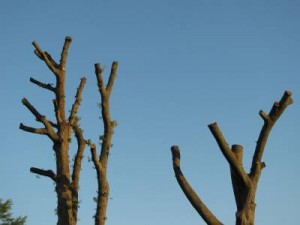
Mature willow oaks disfigured by topping
When a home owner fears that a tree is too large and may fall on their home, often they hire a tree service to reduce the tree’s height by topping it. However topping destroys a tree’s natural architecture, reduces it’s food-making capacity, and creates large wounds that are vulnerable to insect invaders and severe fungal decay. The solution for healthier, stronger, safer trees is not topping, but proper care based on a thorough understanding of tree physiology and tree biomechanics.
Immediately after a storm, when a fallen tree is shown on local television or in the newspaper, our company receives an increased number of requests for tree removal or tree topping. Property owners taking proactive steps to minimize tree hazards is reasonable, but removing or topping healthy, structurally sound trees is not an appropriate response. Trees that fail are usually defective and often these defects are inflicted by people, and consequently, avoidable. If we are to enjoy the benefits of trees while avoiding the potential dangers, we need to properly care for trees throughout all phases of its life, from selection and planting to senescence.
What is Tree Topping?
Tree topping is when branches are indiscriminately lopped off, giving the tree an appearance of a hat rack on steroids.
How Does Tree Topping Cause Damage?
Trees need foliage to manufacture food. Removing all or most of the foliage puts the tree on a starvation diet. To grow new foliage the tree depends on sugars stored in the roots and stem. If the tree has been previously stressed, it may not have enough stored sugars and will begin to decline and die.
In order to continue manufacturing food for itself the tree will activate growth from epicormic buds which we observe as “water sprouts”. These epicormic branches, or water sprouts, must grow vigorously and quickly to replace lost foliage if the tree is not to starve. These new epicormic branches lack a strong branch collar and are weakly attached to the parent branch. As they grow they are significantly more prone to breakage and failure than normal branches.
Tree topping opens large wounds and compromises the tree’s chemical defense system. Attacks from insects, disease, and fungal pathogens will almost always follow. Substantial decay develops, the tree becomes sick and often never recovers. Robbed of their leaves, thin-barked trees have no defense against the intense rays of the summer sun. Bark damage is the usual result.
Topping permanently destroys the tree’s natural architecture, rendering it an ugly mass of conspicuous wounds and epicormic branches sprouting like a witch’s broom. Topped trees will never regain their former beauty and grandeur.
What’s the Appropriate Method to Reduce a Tree’s Height?
The appropriate solution is to plan ahead. Plant the right tree in the right location. By knowing the mature size of the tree you have selected, you can place it in an ideal location, one that has sufficient soil volume and enough airspace, giving the tree a chance for a long life span, allowing yourself, the community, and local wildlife to reap the maximum benefit a mature tree provides.
Unfortunately, sometimes we “inherit” mature trees that have too little space to thrive. One option of acceptably reducing a tree’s overall height and width is crown reduction. Crown reduction is a standard pruning technique, but one that should be employed judiciously. Many times a higher branch, or a leader, can be cut back to a lateral branch that is at least one-third the diameter of the limb being removed. In other words, pruning cuts are made at the intersection of branches, or nodes, in contrast to topping cuts which are usually internodal. We don’t often recommend this technique to reduce the entire crown of a tree. It is usually only appropriate to provide clearance for a home or other structure. Additionally it is important to minimize the amount of foliage removed.
Tree topping is an unacceptable pruning method. Industry standards have been developed to assist arborists in proper tree care. Achieving the desired pruning objective with minimal damage to the tree is the sign of a knowledgeable and skilled arborist. Insist that anyone who prunes your trees uses and abides by the ANSI A300 Standards for Tree Care Operations.
